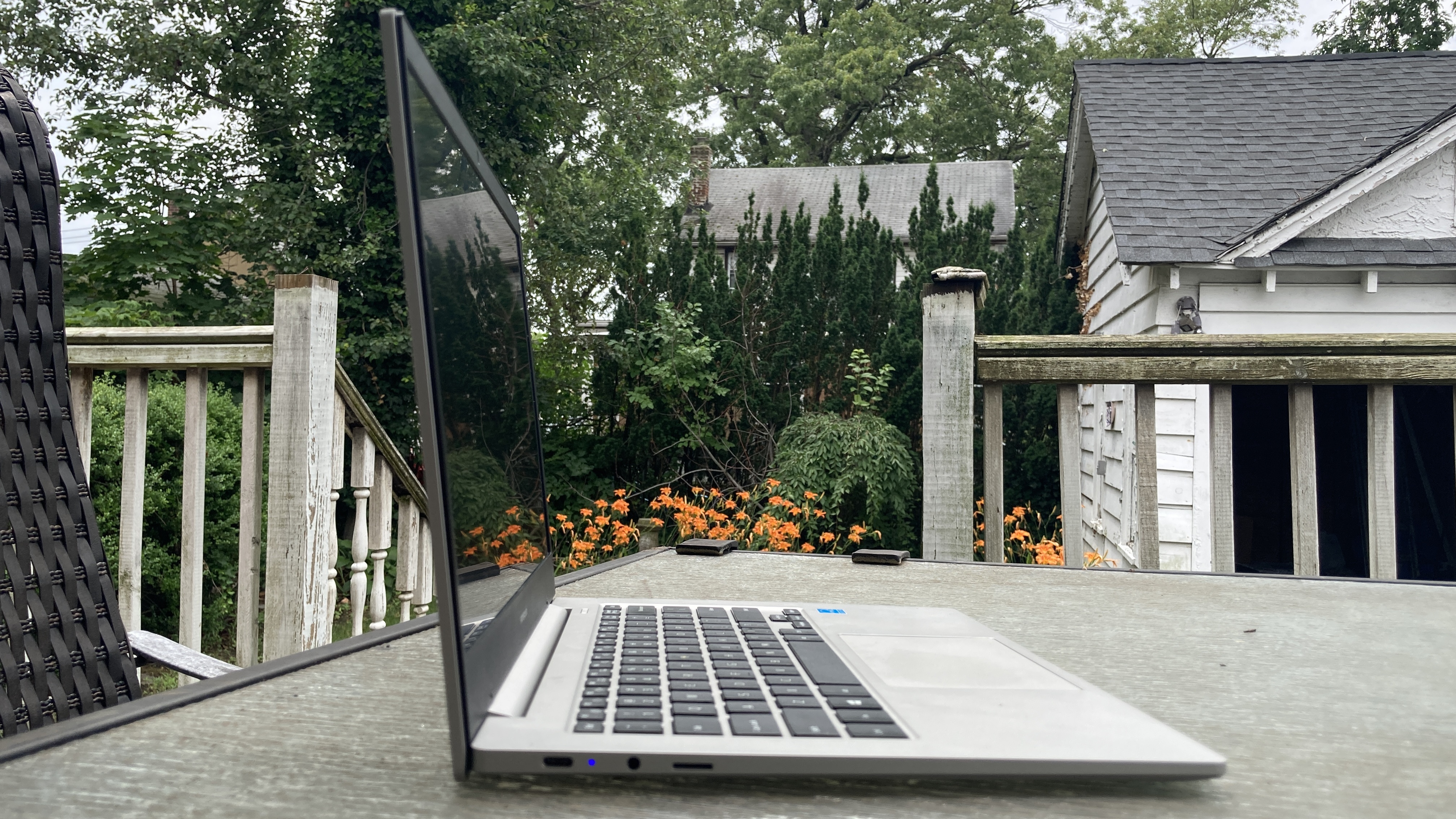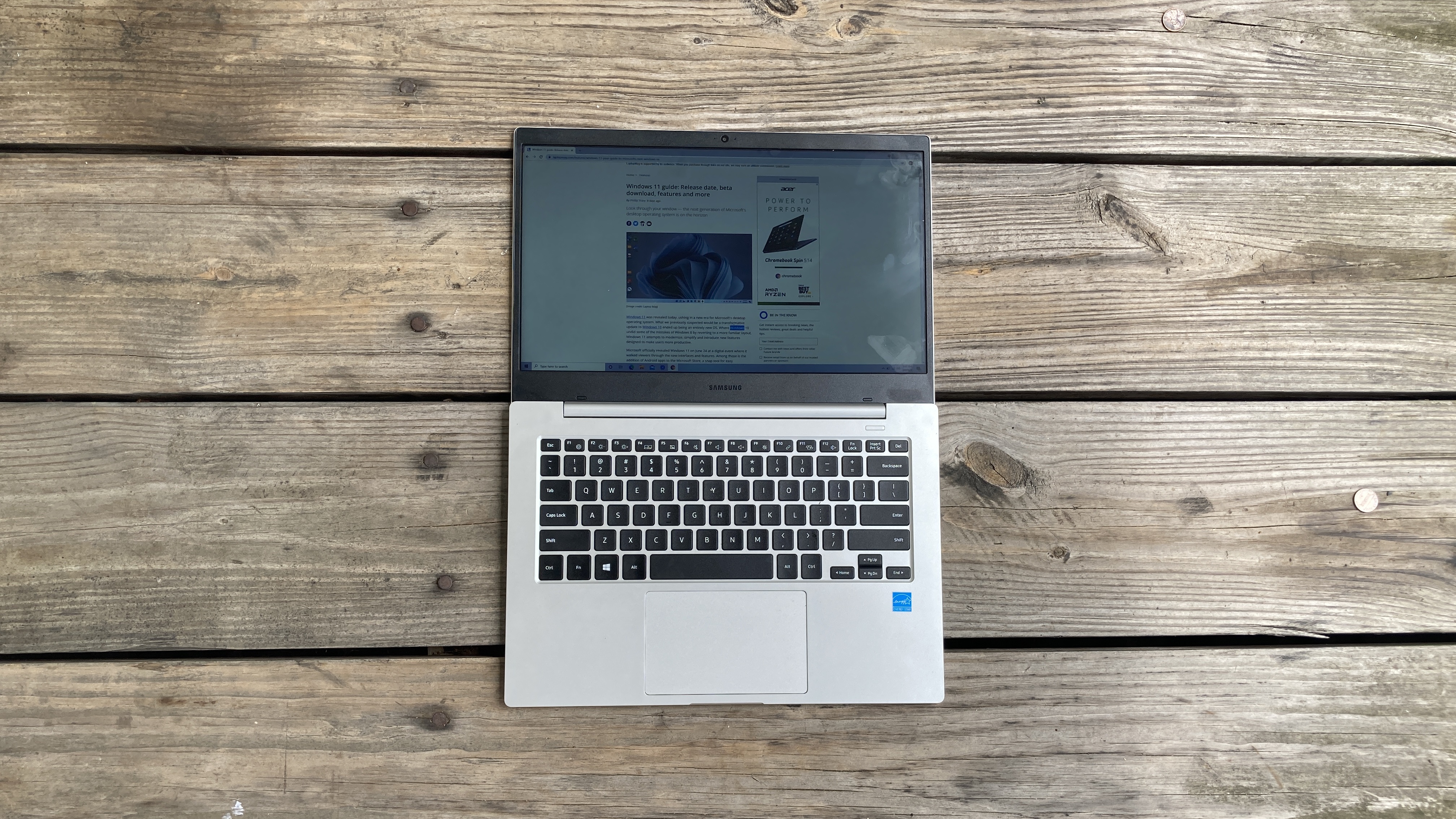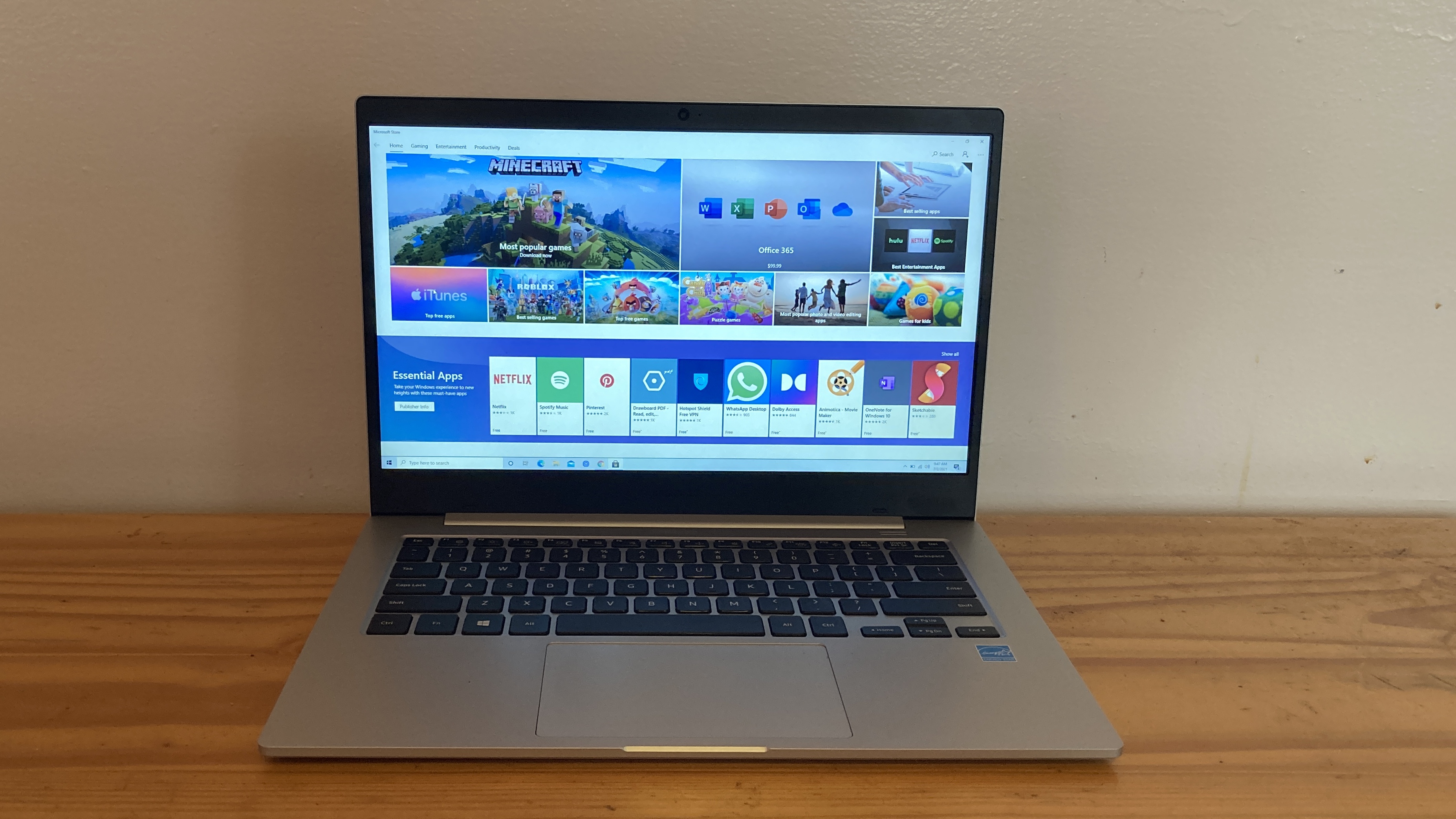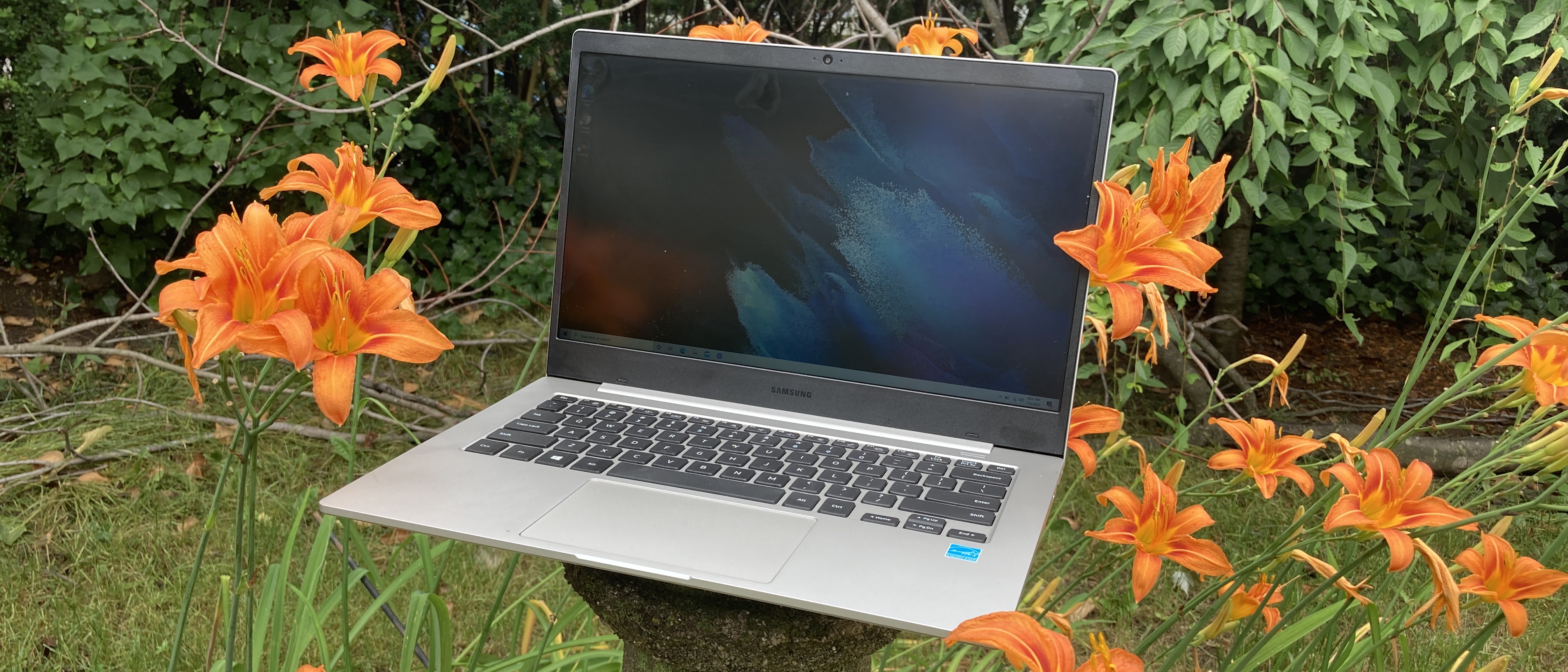Laptop Mag Verdict
The Samsung Galaxy Book Go is a $349 Windows-on-ARM laptop with excellent battery life, but its laggy performance overshadows its endurance.
Pros
- +
Great battery life
- +
Satisfactory speakers
- +
Decent keyboard
Cons
- -
Dim, washed-out display
- -
Storage not upgradeable
- -
Awful touchpad
- -
App incompatibility issues
Why you can trust Laptop Mag
Price: $349
CPU: Qualcomm Snapdragon 7c Gen 2
GPU: Qualcomm Adreno GPU
RAM: 4GB
Storage: 128GB
Display: 14-inch, 1920 x 1080
Battery: 12:49
Size: 12.8 x 8.9 x 0.6 inches
Weight: 3.2 pounds
The Samsung Galaxy Book Go is like the troublemaker toddler who drives the babysitter nuts for being a disobedient lil’ rascal. You see, before I got the “pleasure” of reviewing this, er, interesting laptop, it landed in the hands of our lab tester — and it gave him total hell.
“Almost anything that required a separate download wouldn’t run because of its nonstandard processor,” our lab tester said with a stressed, defeated tone. The Galaxy Book Go, packed with a Snapdragon 7c Gen 2 chip (an ARM CPU), crashed several times during our testing for this review. Like a parent fuming over a teacher’s less-than-favorable appraisal of their child, I wanted to yell “Shame on you!” at the Samsung laptop for being such an uncooperative brat.
Despite its stubborn behavior, I have a little soft spot for the Galaxy Book Go. After all, it offers Windows-on-ARM to consumers who can’t afford to spend more than $400 on a laptop. Plus, the average budget-friendly laptop user doesn’t give a hoot that the Galaxy Book Go can’t run benchmarking apps. However — hint, hint — it being a total nightmare during testing forebodes incompatibility issues with some programs that people do care about.
The Galaxy Book Go does have some redeeming qualities, though. The battery life is impressive, the keyboard isn’t half bad — and um — I’m sure I can find more great things to say about it if I think long and hard enough. That being said, let's dive into whether this $349 Windows-on-ARM laptop is worth your hard-earned money (hint: it’s not).
Samsung Galaxy Book Go price and configuration
The only Samsung Galaxy Book Go configuration available starts at $349 and comes with a Qualcomm Snapdragon 7c Gen 2 processor, a Qualcomm Adreno GPU, 4GB of RAM, 128GB of eUFS storage, and a 14-inch, 1920 x 1080-pixel display.
The Galaxy Book Go comes only in Mystic Silver.
Samsung Galaxy Book Go design
Don’t worry. No one is going to Nelson Mutz you and yell “Haha! You have a cheap ol’ laptop!” At first glance, the Galaxy Book Go looks like your typical silver, mid-range laptop that half the world owns. Onlookers won’t be able to tell you spent less than $400 on it — as long as they don’t touch it.
Sign up to receive The Snapshot, a free special dispatch from Laptop Mag, in your inbox.

The chassis is wrapped in a Mystic Silver hue and a lustrous, twinkling Samsung insignia can be found on the center-left of the lid.
Open the lid and the display gives off unfashionable vibes with its thick bezels and enormous chin. There’s an island-style keyboard featuring white letters and symbols superimposed on black keys. I pushed the deck down to test its sturdiness; it does have a little flex, but it’s not a cause for concern. Yes, the laptop does feel cheap, especially the keyboard and touchpad, but what did you expect from a $349 laptop?
The display can be rotated flat thanks to the 180-degree hinge. This could be useful for rambunctious, boundary-testing children who love exploring the limits of how far a display can bend. The Galaxy Book Go’s design is as basic as you can get; I don’t even know how I came up with more than 10 words to describe it.

The Galaxy Book Go has dimensions of 12.8 x 8.9 x 0.6 and weighs 3.2 pounds. For this review, we compare the Galaxy Book Go to other sub-$400 devices, including the Microsoft Surface Go 2 (9.7 x 6.9 x 0.3 inches, 1.8 pounds), the 14.1-inch Gateway Ultra Slim Notebook (13.1 x 8.9 x 0.8 inches, 3.5 pounds) and the Asus Chromebook Detachable CM3 (12.7 x 8.9 x 0.7, 1 pound).
Samsung Galaxy Book Go ports
The Galaxy Book Go is a little stingy with its ports.

On the left side, you’ll find a USB Type-C port, a headset jack and a microSD card slot, which is useful for additional storage. The 128GB of internal storage in the Galaxy Book Go may run out more quickly than you think. After downloading only Google Chrome, I checked the storage and I was shocked to see that half of it was already used (Windows likely took up a large chunk of space). It’s only a matter of time before the “Low Disk Space” messages pops up to haunt me. You can’t upgrade the storage internally, but you can get an SD card with up to 1TB of storage to supplement what you already have.
On the right side is another USB Type-C port, a USB 2.0 port and a Kensington lock slot.
Samsung Galaxy Book Go display
The Samsung Galaxy Book Go is outfitted with a 14-inch, 1920 x 1080-pixel LED display. The panel’s washed-out colors remind me of a faded graphic T-shirt, but keep in mind that this is a sub-$400 — so temper your expectations.

Clifford the Big Red Dog looked more like Clifford the Big Magenta Dog in a YouTube trailer I watched. The giant dog’s huge, expressive brown eyes seemed vacant and dull on the Samsung laptop. Kenan Thompson’s rich brown complexion looked more subdued than usual. However, I could still make out the endearing crow’s feet that appeared around Thompson’s eyes when he smiled.
The display seems to radiate cooler tones than your typical 1080p display. The sharpness is alright, but the low brightness makes the panel appear less crisp. If you’re not nitpicky about having a top-of-the-line display (and I doubt you would be if you’re on the hunt for a budget laptop), the Galaxy Book Go’s panel is OK for Netflix streaming, YouTube watching and more.
The Samsung laptop is as dim as a dying flashlight, emanating a 201-nit brightness average. This is dimmer than the average budget laptop (225 nits), the Ultra Slim Notebook (246 nits), the Chromebook Detachable CM3 (386 nits) and the Surface Go 2 (408 nits).

Just as I suspected, the Galaxy Book Go’s DCI-P3 color gamut coverage is unimpressive at 42%. This is worse than the average budget laptop (45%), the Ultra Slim Notebook (48%), the Surface Go 2 (76%) and the Chromebook detachable CM3 (94%).
Its 0.2 Delta-E color accuracy score isn’t too bad though (the closer to zero, the better); the Galaxy Book Go beat the Surface Go 2 (0.24), the Chromebook Detachable CM3 (0.34), the Ultra Slim Notebook (0.86), but not the category average (0.19).
Samsung Galaxy Book Go audio
For a sub-$400 laptop, the dual speakers on the Galaxy Book Go sound pretty damn good.

I listened to “Beggin’” by Italian rock band Måneskin on Spotify; I said “Not bad!” as the bottom-firing speakers emanated a booming acapella male voice that sent a chill down my spine. The gritty crooning was well balanced with the sweet-sounding guitar riffs and cymbals.
There is a Dolby Access app that lets you tune the speakers to your liking. There are five presets: Dynamic, Game, Movie, Music and Voice. “Beggin’” sounded the best with the Dynamic profile, which identifies the audio content and performs automatic adjustments to deliver the best sound.
I cranked up the Galaxy Book Go’s speakers to its maximum volume setting. It’s not kill-your-eardrums loud, but the amplification was adequate enough to fill my medium-sized testing room.
Samsung Galaxy Book Go keyboard and touchpad
The Galaxy Book Go’s island-style keyboard doesn’t have the deepest travel, but I typed on it like a dexterous pianist at a symphony concert nonetheless. Although the keys feel cheap, they’re bouncy and tactile. On the 10FastFingers.com typing test, I reached 90 words per minute with an accuracy rate of 99.7%. This is slightly better than my 87-wpm average.

By the way, this keyboard doesn’t have any backlighting, so unless you have night vision-equipped eyeballs, you’ll have to squint for dear life in low-light environments.
I appreciate that Samsung didn’t place the power button on the top-right corner of the keyboard, next to the delete key. It’s sitting pretty above the function keys, far away from the onslaught of my wild, typing fingers.
The 3 x 4.7-inch touchpad is a disobedient devil. If it could talk, I’d bet it’ll only have one word in its vocabulary: “No!” At unpredictable times, the cursor refused to budge in response to my gestures. After a few frantic swipes, the cursor would move again. It’s as if the touchpad said, “I’ll move when I wanna move!” And when the cursor is responsive, it’s like a three-year-old who has trouble keeping up with your fast walking pace. On the plus side, it’s pretty spacious. But what good is all that territory if the touchpad is subpar?
Samsung Galaxy Book Go performance and graphics
I’ve watched a snail move faster than the Galaxy Book Go. Packed with a Qualcomm Snapdragon 7c Gen 2 CPU and 4GB of RAM, the Samsung Windows-on-ARM laptop buckled under pressure when I crowded Google Chrome with 30 tabs. I fired up a fresh Google Docs to test its multitasking muscle, and it lagged like a flashy, cluttered MySpace page from 2006.

Forget about the 30 tabs. I’ve experienced slowdowns while using Chrome with one tab. Currently, Windows-on-ARM devices only support the 32-bit version of Chrome, which runs through a Microsoft x86 emulator. With an emulator acting as a middleman, I experienced some performance degradation. Case in point: When I tried to run the 10FastFingers.com test on Chrome, it was lag central.
If you’re a Chrome fan, I’m sorry to say it, but the Galaxy Book Go is not for you. You’d have to settle for Microsoft Edge or Mozilla Firefox; both offer native versions for Windows-on-ARM PCs.
As mentioned at the outset of this review, the Galaxy Book Go’s 64-bit processor wasn’t particularly cooperative during our testing. It failed to run WebXPRT 3 (a browser benchmark), the Handbrake app (a video transcoding test), Adobe Photoshop Elements and 3DMark (a graphics benchmarking software).
Fortunately, we still managed to secure one benchmarking result from the Galaxy Book Go: Geekbench.
When we ran Geekbench 5.4, an overall performance test, the Samsung’s Snapdragon 7c Gen 2 processor notched 1,653 — the same score as the average budget laptop. The Galaxy Book Go also managed to beat the Surface Go 2’s Intel Core m3-8100Y CPU (1,617) and the Chromebook Detachable CM3’s MediaTek 8183 processor (1,412), but it unsurprisingly could not stave off the Gateway’s Intel Core i5-1035G1 CPU (3,369).

It’s worth noting that our lab tester tried to run Sid Meier’s Civilization IV: Gathering Storm on the Samsung laptop to test its gaming capabilities, but he couldn’t install it. Don’t even think about playing any demanding games on the Galaxy Book Go; it doesn’t have the appropriate internals to handle that kind of stress.
Samsung Galaxy Book Go app compatibility
The Galaxy Book Go may be fine for basic word processing, web browsing and streaming, but if you want to step beyond those boundaries, you may run into some compatibility issues. The chip that powers the Galaxy Book Go is a 64-bit ARM processor, which means it can run ARM64 (64-bit), ARM32 (32-bit) and x86 (32-bit) apps, however, 64-bit (x64) apps won’t work.

Many developers offer 32-bit versions for Windows-on-ARM users, so app limitations for the Galaxy Book Go aren't as awful as you may think. For example, I enjoy using Inkscape (a graphics software for drawing comics during my spare time). Luckily, the developer offers a 32-bit version, so I had no issues doodling away on the app. You’ll also find 32-bit versions of popular apps like Microsoft Word, OBS Studio, Audacity, DaVinci Resolve and Steam. I was able to install and use all of these programs without a hitch.
It’s worth noting though that Adobe Photoshop Elements and Dropbox caused some issues. The former failed to install and the latter prompted me to download Dropbox for S Mode after receiving an incompatibility error.
ARM64 apps are preferred because they’re optimized for Windows-on-ARM PCs; 32-bit versions will work, but they require simulation software, which hinders the performance. For example, you’ll be able to run Google Chrome on the Galaxy Book Go, but it’s sluggish.
So why hasn’t Google launched a native ARM version of Chrome yet? Well, according to Qualcomm, it’s not a technical hurdle — there’s a policy hindrance. According to a Neowin report, Chrome for Windows-on-ARM was ready to hit the market two years ago, but Google refused to release it. “There seems to be some kind of disagreement between Google and one of the other companies involved (either Qualcomm or Microsoft),” Neowin said.

Qualcomm said that Chrome’s native ARM version works like a charm — it’s just a matter of Google making the final call to release it to the public after the policy issues get resolved. I’m not sure what kind of policy problems are plaguing Google and its partners, but they’d better get it together. There are Windows-on-ARM users who need a smooth-performing version of Chrome (and other apps) for their day-to-day tasks.
Google isn’t the only culprit here, though. Most developers simply aren’t going out of their way to build ARM64 apps.
Samsung Galaxy Book Go battery life
The Galaxy Book Go finally has a chance to shine after suffering a mean butt-whooping throughout this review — its battery life is spec-friggin’-tacular. This was expected, though. The Qualcomm Snapdragon 7c Gen 2 chip is known for being energy efficient.

The Samsung laptop lasted a whopping 12 hours and 49 minutes on the Laptop Mag battery test, which involves continuous Web surfing over Wi-Fi at 150 nits of brightness. The Galaxy Book Go survived longer than the average budget laptop (8:48), the Ultra Slim Notebook (7:57), the Chromebook Detachable CM3 (11:41) and the Surface Go 2 (11:39).
Samsung Galaxy Book Go webcam
The unimpressive 720p webcam, housed on the top bezel, is no different from the scores of other poor laptop cameras on the market. The Galaxy Book Go may be a Samsung, but don’t expect the Galaxy S21’s touch on this webcam.

On the plus side, the webcam renders colors accurately, capturing the chipped, burgundy polish on my nails and a nearby book with a gradient of colors, including mustard yellow and mauve. However, the image quality lacks sharpness and crispness, and there is some visual noise.
Check out our best external webcams page to get something that will make your video-conferencing calls look more professional.
Samsung Galaxy Book Go heat
After enduring a 15-minute 1080p video, the Galaxy Book Go remained cool under pressure on our heat test. The underside climbed to 82.4 degrees Fahrenheit, which is well below our 95-degree comfort threshold. The touchpad and the center of the keyboard reached 74.3 degrees and 79 degrees, respectively. The hottest location of the laptop, clocking in at 88.9 degrees, was the underside (about two inches from the center).
Samsung Galaxy Book Go software and warranty
The Galaxy Book Go comes with Windows 10 Home, and there are some preinstalled apps that you may categorize as bloatware, including the Booking.com Partner App (Samsung Edition), Microsoft Solitaire and Skype.

There’s also a crapload of Samsung-branded apps that are itching to drag Galaxy Book Go users into the Samsung ecosystem (if they aren’t already in it), including SmartThings, Samsung TV Plus, Samsung Flow and Samsung Notes. If you have a compatible Samsung phone, TV, tablet and/or smart-home device, they will all work cohesively and seamlessly with the Galaxy Book Go. One useful app called Quick Share lets users instantly transfer data from their Galaxy devices to the Samsung laptop.
The Galaxy Book Go comes with a one-year limited warranty. See how Samsung fared on our Tech Support Showdown and Best and Worst Brands special reports.
Bottom line
I’d only recommend the Galaxy Book Go to one specific type of consumer: the budget-conscious Samsung Galaxy loyalist who uses non-Chrome browsers (i.e. Edge and Firefox) for ultra-basic, low-intensity workflows.
I’d also suggest gifting this laptop to someone you despise — like your mother-in-law. It’s a great way to give ‘em hell while masquerading your subterfuge as a “gesture from the heart.” Don’t feel too bad — at least they’d appreciate the 13-hour battery life.
If you want a decent sub-$500 laptop sans app incompatibility issues, consider the Gateway Ultra Slim Notebook. Like the Galaxy Book Go, it’s a 14-inch laptop but it uses a 10th Gen Intel processor, so you don’t have to worry about whether apps will play nice with your laptop. As of this writing, the Gateway laptop only costs $299 at Walmart. One downside, though, is that it’s not as power efficient as the Galaxy Book Go; it lasts 8 hours on a charge.
I really wanted to like the Galaxy Book Go — it would have been nice to add it to our best laptops under $500 page. Samsung is one of the most reliable tech brands, but this Windows-on-ARM PC just didn’t make the cut.
Kimberly Gedeon, holding a Master's degree in International Journalism, launched her career as a journalist for MadameNoire's business beat in 2013. She loved translating stuffy stories about the economy, personal finance and investing into digestible, easy-to-understand, entertaining stories for young women of color. During her time on the business beat, she discovered her passion for tech as she dove into articles about tech entrepreneurship, the Consumer Electronics Show (CES) and the latest tablets. After eight years of freelancing, dabbling in a myriad of beats, she's finally found a home at Laptop Mag that accepts her as the crypto-addicted, virtual reality-loving, investing-focused, tech-fascinated nerd she is. Woot!


